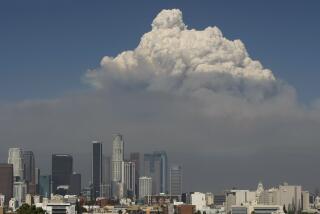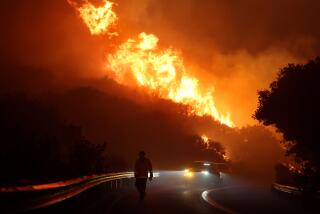Op-Ed: Some wildfires simply can’t be fought
There is a cadence to fire season and a predictability to the headlines: A wildfire is burning, homes are threatened, residents are urged to evacuate.
We’ve grown used to watching the air-and-ground assaults. The image of a DC-10 dumping retardant on burning brush is an indelible symbol of our attempt to control nature. We’ve come to expect that firefighters will bring flames into submission because they so often have — and this has made us comfortable.
Perhaps too comfortable. Despite the reassuring images of firefighters conquering wildfires, the truth is that once a large fire is burning, there’s very little that firefighters can do to stop it, or to protect homes nearby. Faced with the decision to risk their lives to save somebody’s property or let the property burn, firefighters know that there is only one sensible choice.
Fire feeds on grass and fallen leaves. It uses brush and toppled branches to climb onto the crowns of trees, where it then takes off. You cannot subdue rushing flames with shovels, picks, power saws and axes — the tools that firefighters carry. The best strategy is to retreat.
Since 1990, 60% of all new housing units in the U.S. have been built on the edge of forests.
If firefighters don’t withdraw or hold back when they should, they pay the ultimate price. State forestry officials made the wrong calculation in Arizona in 2013, for instance, and 19 firefighters died. The men, all members of an elite, highly skilled team called the Granite Mountain Hotshots, were swallowed by a giant wave of flames as they trudged through thick, unburned brush toward a community they were trying to protect. Their deaths serve as an awful reminder that some fires simply can’t be fought.
This is increasingly the case, as forests in the United States become ever more flammable. Larger areas are primed for burning, choked by overgrowth and parched by a warming climate that quickly turns grass into kindling. Wildfires have become bigger, more intense and more frequent. In most Western states, the number of large wildfires ignited annually has at least doubled since the 1970s, and the fire season is longer by almost three months.
Overgrown forests have struggled through a punishing six-year drought in California. More than 100 million trees died during these years, according to the California Department of Forestry and Fire Protection. The drought had weakened them and bark beetles had finished them off. Although last winter’s rain and snowfall lifted the state out of drought, the moisture also created the perfect conditions for wildfires. Much of the vegetation that sprouted from the moist soil dried up when the temperatures climbed.
This is why the Detwiler fire, which is still burning near Yosemite, spread so quickly. The area was covered in dead trees — fuel for flames. Ten days in, the fire had consumed more than 80,000 acres, destroyed 67 structures and required more than 4,000 firefighters to bring it under control.
In Arizona, where I live, the Ponderosa pine forests are ripe for wildfires. Many of these forests had about 40 trees per acre in the 1950s; today, the same areas have as many as 1,000 per acre, according to some scientists. Michael Kodas, the author of a forthcoming book on the phenomenon of “megafires” — especially large and devastating forest fires — compares such forests to crowded cities, where “disease spreads much easier” and the competition for resources is fierce.
And yet, on the premise that wildfires can be fought, or perhaps because we are not fully aware of the risks, we continue building homes ever closer to forests and other vulnerable areas. According to a 2016 report by the data company CoreLogic, 1.8 million homes across 13 Western states are at extreme or high risk of wildfire damage. One in three of these homes is in California.
Overall, since 1990, 60% of all new housing units in the U.S. have been built on the edge of forests. Such developments are big business for builders and communities looking to expand their tax base — but an increasingly risky one.
Rather than assuming we can fight wildfires, we need to learn to live with them, and with the reality that they are inevitable.
We can do this, first, by taking measures to prevent them. Some 95% of wildfires in California are caused by humans. Nationally, that rate is 84%. Sometimes they are started by an abandoned campfire. Other times, by a cigarette that was carelessly disposed of. The Trabuco Fire, which burned about 20 acres in Orange County last September, started when a golf club struck a rock and sent sparks flying. To prevent such fires, we need to take seriously all of the common-sense recommendations made by Smokey the Bear. Don’t build campfires in dry conditions. When you do build one, make sure it is extinguished.
But we should also prepare for inevitable wildfires by doing our part to make our homes less flammable — by regularly trimming trees, keeping tall trees spaced apart, removing dead vegetation from under decks and pine needles from on top of them, and cleaning out gutters.
Above all, we need to accept that if we choose to live on the edge of woodlands, our homes may very well end up in the path of a wildfire and there might be nothing firefighters can do to save them. This means calibrating our priorities to value the lives of firefighters more than our property.
Fernanda Santos is a professor at Arizona State University’s Walter Cronkite School of Journalism and Mass Communications and the author of “The Fire Line: The Story of the Granite Mountain Hotshots.”
Follow the Opinion section on Twitter @latimesopinion or Facebook
More to Read
A cure for the common opinion
Get thought-provoking perspectives with our weekly newsletter.
You may occasionally receive promotional content from the Los Angeles Times.










